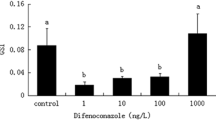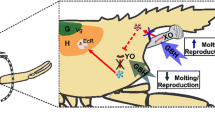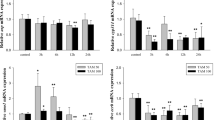Abstract
Triadimefon (TDF) is a systemic wide-spectrum antifungal compound that is widely used in agriculture to inhibit fungal growth on various crops. Since previous studies focused on the embryo and adult life stages in the investigation of ecological impact, here we investigated the long-term effects of TDF (1, 10, 100 μg/L) on rare minnow during its larvae development. TDF caused an anti-estrogenic effect by decreasing vitellogenin (VTG) and CYP19a mRNA level, and inhibiting the aromatase activity and VTG levels after a 3, 6, 10, or 14-day exposure in rare minnow larvae. TDF also disturbed the endocrine disruption by regulating the transcription of estrogen receptors ERα, ERβ1 and ERβ2, CYP1a, CYP11, CYP17, steroidogenic acute regulator (STAR), doublesex and mab-3 related transcription factor (DMRT1), gonadotropin-releasing hormone (GnRH2), GnRH3, GnRHR1A, and GnRHR1B. Furthermore, TDF induced the accumulation of reactive oxygen species (ROS) and the activity of antioxidant proteins glutathione peroxidase (GPX), superoxide dismutase (SOD), and catalase (CAT), and significantly increased the transcriptions of stress response genes P53, growth arrest and DNA damage-inducible 45 alpha (Gadd45α), and COX1, suggested that TDF might cause oxidative stress during larvae development. The changes in transcript and biological levels represented the potential adaptive or compensatory responses to impaired oxidative stress and endocrine system after TDF exposure in rare minnow during its larvae development.






Similar content being viewed by others
References
Barucca M, Canapa A, Olmo E, Regoli F (2006) Analysis of vitellogenin gene induction as a valuable biomarker of estrogenic exposure in various Mediterranean fish species. Environ Res 101:68–73
Bogers R, Mutsaerds E, Druke J, De Roode DF, Murk AJ, Van Der Burg B, Legler J (2006) Estrogenic endpoints in fish early life-stage tests: luciferase and vitellogenin induction in estrogen-responsive transgenic zebrafish. Environ Toxicol Chem 25:241–247
Cao M, Duan J, Cheng N, Zhong X, Wang Z, Hu W, Zhao H (2012) Sexually dimorphic and ontogenetic expression of dmrt1, cyp19a1a and cyp19a1b in Gobiocypris rarus. Comp Biochem Physiol A Mol Integr Physiol 162:303–309
Costa NO, Vieira ML, Sgarioni V, Pereira MR, Montagnini BG, Mesquita Sde F, Gerardin DC (2015) Evaluation of the reproductive toxicity of fungicide propiconazole in male rats. Toxicology 335:55–61
Farajzadeh MA, Khoshmaram L (2013) Air-assisted liquid-liquid microextraction-gas chromatography-flame ionisation detection: a fast and simple method for the assessment of triazole pesticides residues in surface water, cucumber, tomato and grape juices samples. Food Chem 141:1881–1887
Fu Y, Yang T, Zhao J, Zhang L, Chen R, Wu Y (2017) Determination of eight pesticides in Lycium barbarum by LC-MS/MS and dietary risk assessment. Food Chem 218:192–198
Gonzalez-Martin MI, Revilla I, Vivar-Quintana AM, Betances Salcedo EV (2017) Pesticide residues in propolis from Spain and Chile. An approach using near infrared spectroscopy. Talanta 165:533–539
Gustafsson JA (1999) Estrogen receptor beta--a new dimension in estrogen mechanism of action. J Endocrinol 163:379–383
Hermsen SA, Pronk TE, van den Brandhof EJ, van der Ven LT, Piersma AH (2012) Triazole-induced gene expression changes in the zebrafish embryo. Reprod Toxicol 34:216–224
Hsu LS, Chiou BH, Hsu TW, Wang CC, Chen SC (2017) The regulation of transcriptome responses in zebrafish embryo exposure to triadimefon. Environ Toxicol 32:217–226
Jeong HG, Kim JY, Choi CY, You HJ, Hahm K (2001) Suppression of CYP1A1 expression by 4-nonylphenol in murine Hepa-1c1c7 cells. Cancer Lett 165:95–101
Jiang JH, Wu SG, Chen JB, Wu CX, Cai LM, Zhao XP (2015) Acute toxicity effects of triadimefon to different life stages of zebrafish (Danio rerio) and Chinese rare minnow (Gobiocypris rarus). Asian J Ecotoxicol 10:150–156 (in Chinese)
Kim YC, Ariyoshi N, Artemenko I, Elliott ME, Bhattacharyya KK, Jefcoate CR (1997) Control of cholesterol access to cytochrome P450scc in rat adrenal cells mediated by regulation of the steroidogenic acute regulatory protein. Steroids 62:10–20
Konwick BJ, Garrison AW, Avants JK, Fisk AT (2006) Bioaccumulation and biotransformation of chiral triazole fungicides in rainbow trout (Oncorhynchus mykiss). Aquat Toxicol 80:372–381
Lethimonier C, Madigou T, Munoz-Cueto JA, Lareyre JJ, Kah O (2004) Evolutionary aspects of GnRHs, GnRH neuronal systems and GnRH receptors in teleost fish. Gen Comp Endocrinol 135:1–16
Li ZH, Zlabek V, Grabic R, Li P, Machova J, Velisek J, Randak T (2010) Effects of exposure to sublethal propiconazole on the antioxidant defense system and Na+-K+-ATPase activity in brain of rainbow trout, Oncorhynchus mykiss. Aquat Toxicol 98:297–303
Li M, Li S, Yao T, Zhao R, Wang Q, Zhu G (2016) Waterborne exposure to triadimefon causes thyroid endocrine disruption and developmental delay in Xenopus laevis tadpoles. Aquat Toxicol 177:190–197
Li J, Chang J, Li W, Guo B, Wang H (2017) Disruption of sex-hormone levels and steroidogenic-related gene expression on Mongolia Racerunner (Eremias argus) after exposure to triadimefon and its enantiomers. Chemosphere 171:554–563
Liang X, Wang M, Chen X, Zha J, Chen H, Zhu L, Wang Z (2014) Endocrine disrupting effects of benzotriazole in rare minnow (Gobiocypris rarus) in a sex-dependent manner. Chemosphere 112:154–162
Lin CH, Chou PH, Chen PJ (2014) Two azole fungicides (carcinogenic triadimefon and non-carcinogenic myclobutanil) exhibit different hepatic cytochrome P450 activities in medaka fish. J Hazard Mater 277:150–158
Liu SY, Jin Q, Huang XH, Zhu GN (2014) Disruption of zebrafish (Danio rerio) sexual development after full life-cycle exposure to environmental levels of triadimefon. Environ Toxicol Pharmacol 37:468–475
Livak KJ, Schmittgen TD (2001) Analysis of relative gene expression data using real-time quantitative PCR and the 2(-Delta Delta C(T)) method. Methods 25:402–408
Livingstone DR (2001) Contaminant-stimulated reactive oxygen species production and oxidative damage in aquatic organisms. Mar Pollut Bull 42:656–666
Luo X, Yao ZW, Qi HB, Liu DD, Chen GQ, Huang S, Li QS (2011) Gadd45alpha as an upstream signaling molecule of p38 MAPK triggers oxidative stress-induced sFlt-1 and sEng upregulation in preeclampsia. Cell Tissue Res 344:551–565
Martin MT, Brennan RJ, Hu W, Ayanoglu E, Lau C, Ren H, Wood CR, Corton JC, Kavlock RJ, Dix DJ (2007) Toxicogenomic study of triazole fungicides and perfluoroalkyl acids in rat livers predicts toxicity and categorizes chemicals based on mechanisms of toxicity. Toxicol Sci 97:595–613
Menegola E, Broccia ML, Di Renzo F, Prati M, Giavini E (2000) In vitro teratogenic potential of two antifungal triazoles: triadimefon and triadimenol. In Vitro Cell Dev Biol Anim 36:88–95
Millar RP, Lu ZL, Pawson AJ, Flanagan CA, Morgan K, Maudsley SR (2004) Gonadotropin-releasing hormone receptors. Endocr Rev 25:235–275
Mu X, Pang S, Sun X, Gao J, Chen J, Chen X, Li X, Wang C (2013) Evaluation of acute and developmental effects of difenoconazole via multiple stage zebrafish assays. Environ Pollut 175:147–157
Mu X, Chai T, Wang K, Zhang J, Zhu L, Li X, Wang C (2015) Occurrence and origin of sensitivity toward difenoconazole in zebrafish (Danio reio) during different life stages. Aquat Toxicol 160:57–68
Nilsen BM, Berg K, Eidem JK, Kristiansen SI, Brion F, Porcher JM, Goksoyr A (2004) Development of quantitative vitellogenin-ELISAs for fish test species used in endocrine disruptor screening. Anal Bioanal Chem 378:621–633
Paul Friedman K, Papineni S, Marty MS, Yi KD, Goetz AK, Rasoulpour RJ, Kwiatkowski P, Wolf DC, Blacker AM, Peffer RC (2016) A predictive data-driven framework for endocrine prioritization: a triazole fungicide case study. Crit Rev Toxicol 46:785–833
Reeves R, Thiruchelvam M, Richfield EK, Cory-Slechta DA (2004) The effect of developmental exposure to the fungicide triadimefon on behavioral sensitization to triadimefon during adulthood. Toxicol Appl Pharmacol 200:54–63
Roos WP, Kaina B (2013) DNA damage-induced cell death: from specific DNA lesions to the DNA damage response and apoptosis. Cancer Lett 332:237–248
Skolness SY, Blanksma CA, Cavallin JE, Churchill JJ, Durhan EJ, Jensen KM, Johnson RD, Kahl MD, Makynen EA, Villeneuve DL, Ankley GT (2013) Propiconazole inhibits steroidogenesis and reproduction in the fathead minnow (Pimephales promelas). Toxicol Sci 132:284–297
Vanden Bossche H, Marichal P, Gorrens J, Coene MC (1990) Biochemical basis for the activity and selectivity of oral antifungal drugs. Br J Clin Pract Suppl 71:41–46
Wang C, Wu Q, Wu C, Wang Z (2011) Application of dispersion-solidification liquid-liquid microextraction for the determination of triazole fungicides in environmental water samples by high-performance liquid chromatography. J Hazard Mater 185:71–76
Williams TD, Mirbahai L, Chipman JK (2014) The toxicological application of transcriptomics and epigenomics in zebrafish and other teleosts. Brief Funct Genomics 13:157–171
Wu YS, Lee HK, Li SF (2001) High-performance chiral separation of fourteen triazole fungicides by sulfated beta-cyclodextrin-mediated capillary electrophoresis. J Chromatogr A 912:171–179
Wu L, Chang HY, Ma XY (2017) A modified method for pesticide transport and fate in subsurface environment of a winter wheat field of Yangling, China. Sci Total Environ 609:385–395
Zarn JA, Bruschweiler BJ, Schlatter JR (2003) Azole fungicides affect mammalian steroidogenesis by inhibiting sterol 14 alpha-demethylase and aromatase. Environ Health Perspect 111:255–261
Zhu B, Liu L, Gong YX, Ling F, Wang GX (2014) Triazole-induced toxicity in developing rare minnow (Gobiocypris rarus) embryos. Environ Sci Pollut Res Int 21:13625–13635
Acknowledgements
The present study was supported by grants from the National Natural Science Foundation of China (31672054), Public Technology Application Research of Zhejiang Province (2016C32098), State Key Laboratory Breeding Base for Zhejiang Sustainable Pest, and Disease Control (2010DS700124-ZZ1701).
Author information
Authors and Affiliations
Corresponding author
Ethics declarations
Conflict of interest
The authors declare that they have no competing interests.
Additional information
Responsible editor: Cinta Porte
Rights and permissions
About this article
Cite this article
Jiang, J., Hu, G., Zhang, C. et al. Toxicological analysis of triadimefon on endocrine disruption and oxidative stress during rare minnow (Gobiocypris rarus) larvae development. Environ Sci Pollut Res 24, 26681–26691 (2017). https://doi.org/10.1007/s11356-017-0317-3
Received:
Accepted:
Published:
Issue Date:
DOI: https://doi.org/10.1007/s11356-017-0317-3




